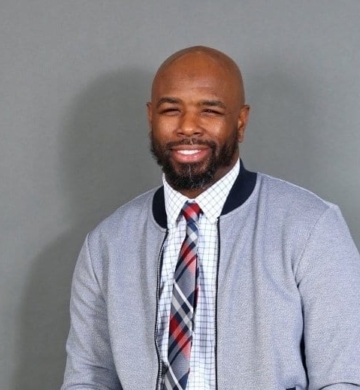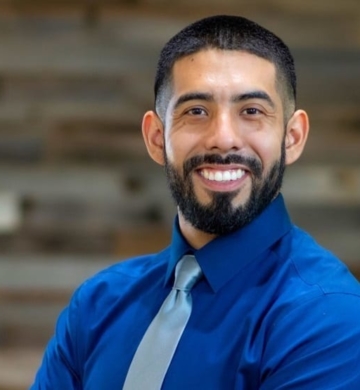A Toolkit for Advancing College Opportunity for Justice-Impacted Students – Illinois
Letter From the Fellows
“Education is freedom.” — Paulo Freire, Pedagogy of the Oppressed
“As a society, our decision to heap shame and contempt upon those who struggle and fail in a system designed to keep them locked up and locked out says far more about ourselves than it does about them.”
— Michelle Alexander, The New Jim Crow: Mass Incarceration in the Age of Colorblindness
For decades, political leaders have used their power to keep incarcerated and formerly incarcerated individuals locked out of higher education. They’ve imposed morally bankrupt, freedom-denying policies and practices, despite the proven, long-term returns of a college education for individuals like us, and broader society.
Higher education institutions have been complicit in the denial of opportunities for justice-impacted individuals. By cutting off access to scholarships, refusing to reduce prison sentences for those enrolled in higher education, and making it difficult and expensive for colleges to run prison education programs, state officials have turned their backs on our parents, siblings, and cousins who yearn to continue their education while on the inside.
By denying previously incarcerated persons access to federal food and housing assistance and allowing colleges to screen out applicants with prior convictions, state officials have stacked the odds against us and made it nearly impossible to pursue a higher education upon release from prison.
By throwing up barriers to employment and election participation based on incarceration history, state officials have all but assured that previously incarcerated individuals remain locked out of full citizenship.
This must change. Our hope is that the information in this toolkit can help.
Together with colleagues at The Education Trust, and with support from partners in the field, we’ve identified several unjust barriers that keep incarcerated and formerly incarcerated individuals from accessing a higher education and benefiting from it and participating fully in society. While we’ve gathered detailed information for eight states, we are calling on elected officials — governors, state legislators, heads of statewide higher education and corrections departments, and others — to immediately remove these barriers wherever they exist and enact more civil and humane policies that will make it easier for students who are, or have been, incarcerated to pursue a higher education. Congressional delegates can also use their influence at the state level to make a positive impact. For advocates engaged in this work, we’ve included tools, such as an op-ed writing guide and a template for creating a “power map” in each state (see our State Decision-Making Agency and Organization Tracker).
We deserve our freedom. We deserve an education. And so do the millions of currently and formerly incarcerated Americans who have been failed by broken systems and poor public leadership.
The federal restoration of Pell Grants for students in prison gives us hope. Let us build on that hope and expand our collective freedom by tearing down the barriers to a higher education that remain in the states.
Justice Fellows

Omari Amili
Frelimo "Omari" Amili is a father of six and program manager with a Seattle-based nonprofit called Choose 180. Following…

Mary Baxter
Mary Enoch Elizabeth Baxter, also known by her hip-hop name, “Isis Tha Saviour,” is an award-winning Philadelphia-based artist who…

Montrell Carmouche
At the age of 21, Montrell was sentenced to 262 months in federal prison. During their 20-year incarceration, Montrell…

William Freeman III
Manager of Higher Education Justice Initiative
William leads and manages the Justice Policy Fellowship, where he works with the policy team to provide an equity…

Alexa Garza
Higher Education Justice Initiatives Analyst/Texas Policy Analyst
Alexa Garza, an alumna of EdTrust’s inaugural Justice Fellows Policy Program, is responsible for assisting with the day-to-day tasks…

Patrick Rodriguez
Patrick was released from prison in December 2019, and since then, he has worked to serve those who have…

Rabia Qutab
Rabia’s life experience has transformed a perceived liability into an asset. As a formerly incarcerated young woman of color,…

Jarrod Wall
During his 26 years of incarceration, Jarrod earned several degrees (AA, BA, BS, MA) and had the privilege to…
Introduction
BY Kayla C. Elliott, Ph.D., Director of Higher Education Policy, and Satra Taylor, Former Manager of Higher Education Justice Initiatives
The United States has the world’s largest prison system. While the U.S. constitutes only 5% of the global population, it has more than 20% of the world’s prison population — with nearly 2.3 million people in jails, prisons, and detention centers, according to estimates by the Prison Policy Initiative. This extreme rate of incarceration is particularly troubling, given that over two-thirds of people who are released from prison are rearrested within three years and more than 75% are rearrested within six years. We have long had a mass incarceration problem marked by vast racial and gender disparities. Due to a combination of factors, including systemic injustice, housing segregation, exposure to crime and violence, under-resourced schools, over-criminalization, bias in the criminal justice system, harsh school discipline and criminal sentencing policies, and a lack of economic opportunities, Black and Latino people and individuals from low-income backgrounds are vastly overrepresented in U.S. prisons and suffer disproportionately from the consequences of incarceration, as a 2020 analysis by New America notes. These consequences include limited educational and employment opportunities, voter disenfranchisement, and ineligibility for housing and public benefits, all of which contribute to distressingly high stress and recidivism rates.
A 2018 study by the Rand Corporation found that individuals who had participated in correctional education programs were 28% less likely to return to custody. These programs were also associated with fewer violent incidents in participating prisons, the Vera Institute of Justice noted. Correctional education programs are an essential strategy for breaking the cycles of incarceration and poverty and helping formerly incarcerated individuals to reintegrate into society. Higher education in prison programs provide a net savings to taxpayers and are significantly more cost-efficient than incarceration. After the 1994 Crime Bill removed Pell Grant eligibility for incarcerated people, the number of higher education in prison programs dropped from 800 programs in nearly 1,300 prisons in the early 1990s to only 12 by the year 2005, according to a 2019 paper on postsecondary prison programs by the National Conference of State Legislatures. After more than two decades, Congress has restored Pell Grant eligibility for individuals who are currently incarcerated. At this moment, people on both sides of the political aisle agree that higher education is a better investment than incarceration and have coalesced around expanding access to a quality higher education for incarcerated individuals. In the 2022-2023 academic year, more than 400,000 incarcerated individuals will become eligible for Pell Grants, the Vera Institute of Justice estimates. Whether by intention or oversight, too many state policies erect barriers for justice impacted students instead of fostering access and affordability.
Led by the inaugural cohort of the Justice Fellows Policy Program, The Education Trust analyzed state support of currently and formerly incarcerated students in eight states where Ed Trust works in coalition with local higher education and justice advocates — California, Illinois, Louisiana, New York, Michigan, Ohio, Tennessee, and Texas.
To be clear, Pell restoration is just the first piece in what should be a broader plan to improve college access and success for students impacted by the criminal legal system. These students often lack access to the internet and to financial information needed to complete the FAFSA and qualify for Pell Grants. As barriers to federal financial aid are lifted, state legislators and higher education leaders must follow suit in removing barriers to enrollment and state financial aid. Policymakers can and should provide individual incentives to currently incarcerated students through sentence-reduction credits, and target funding toward institutions that proactively enroll and support incarcerated students. State leaders should also consider putting policies into place to help students obtain identification, employment, housing and other basic needs, as well as cover tuition and protect their voting rights, which would go a long way toward improving students’ overall success and livelihoods beyond the college campus.
Glossary
Currently incarcerated
Refers to those who are incarcerated in prison after conviction of a state or federal crime, as well as those who are unsentenced or being held in jail before or during trial. Does not include those under probation or parole.
Formerly incarcerated
Refers to people who were previously convicted of a state or federal crime and held in prison. This term may also include people who were held in custody without sentencing and those under supervision — e.g., on probation or parole as a condition of their sentence or release from prison.
State financial aid
State-issued funding for eligible students to enroll in higher education programs at reduced cost. Aid is typically limited to state residents and U.S. citizens.
Sentence reduction credit
Credits given by prisons and state departments of corrections that may reduce the time a currently incarcerated person must stay in prison. Sentence reduction credits are typically awarded for good behavior, productive activities, or successful completion of recidivism reduction programming. These may be “good time credits,” which reduce the actual time a person must serve in prison, or “earned time credits,” which can result in release from prison into a pre-release custody arrangement, such as house arrest or a halfway house. Earned time credits can be earned in addition to good time credits.
Streamlined process for identification
A process that does not place an undue burden on an individual to locate and acquire documents upon their release. A streamlined process assists and supports students while they’re still incarcerated and ensures that they are given/supplied an ID before their release. This process can help individuals who lack the necessary supports — like transportation or someone to guide them in filling out forms — to secure an ID.
Illinois
BY Anna Hyunah Byon, Senior Policy Analyst, Christopher Garcia, Former Higher Education Research Intern, Mysia Perry, Former Higher Education Policy Intern
Does the state offer state financial aid to currently and formerly incarcerated students?
NO, currently incarcerated students are not eligible for any financial aid award funded by the Higher Education Student Assistance Act.
YES, formerly incarcerated students can access state financial aid.
Does the state provide sentence reduction credit to currently incarcerated students for enrolling in higher education courses?
YES, but only in some instances. Currently incarcerated students can obtain good-time credit of up to 90 days for sentences on offenses that occurred before June 19, 1998. Students who are currently incarcerated for an offense committed before June 19, 1998, who obtain degrees while in Illinois Department of Corrections (IDOC) custody can get an additional 180 days of sentence credit. People with natural life sentences or who are required to serve 75%, 85%, or 100% of their sentences are not eligible.
Does the state provide incentives and resources to colleges to enroll and support currently and formerly incarcerated students?
NO, Illinois does not provide incentives and resources to colleges for enrolling these students.
Does the state have a streamlined process for currently incarcerated students to access documents to retrieve their state identification?
YES, Illinois has a streamlined process for students who are currently incarcerated in IDOC facilities to obtain a state ID at no charge. Currently incarcerated individuals should work with IDOC to gather their required documents. IDOC will then coordinate with the Secretary of State’s office to issue a state ID, which will be provided to the individual upon their release. This program is currently under expansion and anticipated to serve 27 IDOC facilities by April 2022.
Does the state allow formerly incarcerated students to access public housing and housing choice vouchers (formerly Section 8), Medicaid, and the federal Supplemental Nutrition Assistance Program (SNAP)?
NO, formerly incarcerated students cannot access SNAP.
YES, formerly incarcerated students can access Medicaid and public housing, with stipulations. Formerly incarcerated students can access housing benefits, but each public housing authority may have different eligibility rules about admitting those with drug-related or violent crime-related convictions.
Formerly incarcerated students should contact each housing authority directly for more information.
Does the state ban institutions of higher education from asking about criminal history on admissions applications?
NO, Illinois does not ban higher education institutions from asking about criminal history.
Does the state ban employers from asking about criminal history on job applications?
YES, Illinois bans employers from disqualifying an applicant because of their criminal record. Senate Bill 1480, which became law in March 2021, prohibits employers from using a person’s conviction record to deny them employment opportunities unless a job has a “substantial relationship” to the person’s conviction.
Do currently and formerly incarcerated individuals have the right to vote in the state?
NO, currently incarcerated individuals do not have the right to vote.
YES, formerly incarcerated individuals have the right to vote. Those with a felony conviction must re-register to vote after release from prison.
Recommendations
![]() 1. Rescind all barriers that prevent formerly and currently incarcerated students from receiving state financial aid.
1. Rescind all barriers that prevent formerly and currently incarcerated students from receiving state financial aid.
Unfortunately, none of the states we analyzed provides unfettered access to state financial aid for currently and formerly incarcerated students. Meanwhile, many financial aid programs in Texas explicitly deny access to currently incarcerated students who have been convicted of certain crimes, as well as formerly incarcerated students within two years of their release. States should not make aid eligibility or award amounts contingent on sentence length, conviction type, or the amount of time since release. States could, and should, make it easier for incarcerated students to access financial aid by investing in college navigators and counselors to help guide these students through the financial aid application process and giving students who are incarcerated time to gather the documentation needed to file the FAFSA. States and institutions can work together to identify ways to absorb application and transcript fees, since most incarcerated students cannot afford these fees.
![]() 2. Allow students to earn equivalent good time credit, as they do for participating in other correctional rehabilitative programs.
2. Allow students to earn equivalent good time credit, as they do for participating in other correctional rehabilitative programs.
Good time credit rewards students’ rehabilitation and learning efforts by reducing their time in prison. States should not restrict good time credit eligibility based on sentence length or conviction type. Though most states in our analysis, except Michigan, offer good time credit for participating in educational programs, every state in our analysis has some eligibility exclusion(s) based on an individual’s sentence length or conviction type. Michigan has not allowed incarcerated people to earn good time credit for participation in educational programs since 1978, when Michigan voters passed a ballot initiative that removed the good time provision.
![]() 3. Provide resources and supports to institutions that enroll justice-impacted students.
3. Provide resources and supports to institutions that enroll justice-impacted students.
States should provide robust funding for higher education in prison and reentry programs and ensure collaboration between education, workforce, and criminal justice agencies and stakeholders. This not only incentivizes institutions to provide access but provides institutions with the necessary funding and capacity to support these students and programs. In Tennessee, the Office of Criminal Justice Programs (OCJP) created the Evidence-Based Jail Programming project to provide $5 million for programs proven to reduce recidivism rates and increase local collaboration to improve outcomes for formerly incarcerated persons. Additionally, Tennessee created a post-secondary education coordinator and post-secondary education program liaison to establish and administer these programs for the Tennessee Department of Correction. States can offer subsidies to help ensure that program costs do not exceed the value of the Pell Grant or other funding the institution may have received to support that program, and that no tuition, debt, or other charges are passed on to enrolled students in the form of out-of-pocket payments or loans that must be repaid. State-level coordination and support can also facilitate students’ future career and educational goals by fostering accreditation, articulation agreements, transferability of credits, and admission and comprehensive support services for students.
![]() 4. Implement a streamlined process for incarcerated students to retrieve their birth certificate, state ID, and driver’s license.
4. Implement a streamlined process for incarcerated students to retrieve their birth certificate, state ID, and driver’s license.
A streamlined process does not place an undue burden on students coming out of prison, but rather assists and supports them in preparing for reentry. States should not assume that an individual has access to transportation and/or family support to help them get their birth certificate, state ID, and driver’s license. In Tennessee, each facility has a designated reentry team — consisting of a counselor, an institutional probation parole officer (IPPO), and a career development specialist — to assist individuals in reentry planning. Incarcerated individuals who are within 24 months of release are eligible for reentry services, including the following: help in obtaining a state identification and birth certificate; assistance in applying for benefits, including veterans’ benefits, supplemental security income, disability, Social Security, and Medicare or Medicaid; residency planning assistance and help in finding housing; and employment planning assistance. By contrast, Illinois lacked a streamlined process for currently incarcerated students to obtain a state ID until recently; prior to November 2021, currently incarcerated students had to go to a Secretary of State’s office with required documents in hand within 30 days of release in order to receive a free ID card. Illinois is now expanding a program that lets students who are currently incarcerated in Illinois Department of Corrections (IDOC) facilities obtain a state ID at no charge. Currently incarcerated individuals work with Illinois Department of Corrections (IDOC) to gather their required documents. IDOC will then coordinate with the Secretary of State’s office to issue a state ID, which will be provided to the individual upon release.
![]() 5. Make formerly incarcerated individuals eligible for state and federal programs that provide support for basic needs such as food, housing, and health care.
5. Make formerly incarcerated individuals eligible for state and federal programs that provide support for basic needs such as food, housing, and health care.
Since 2015, at least 14 states — Alabama, Alaska, Arizona, Arkansas, Delaware, Georgia, Indiana, Louisiana, Mississippi, North Dakota, South Dakota, Texas, Virginia, and West Virginia — have lifted or modified the ban on SNAP or Temporary Assistance for Needy Families (TANF) programs for those with prior drug convictions. Yet at least seven states — Arizona, Georgia, Missouri, Nebraska, South Carolina, Texas, and West Virginia — still have a full ban in place for one or more basic needs programs. Assistance with basic needs helps to ease reentry and reduce recidivism and provides a safety net and starting point for formerly incarcerated people. States should have teams in place to help currently incarcerated students apply for assistance before release, so their basic needs can be met. Food and housing insecurity can negatively impact students’ mental and physical health and prevent them from enrolling or persisting in higher education programs.
![]() 6. Ban public and private colleges and universities from asking about an individual’s criminal history on initial admissions applications.
6. Ban public and private colleges and universities from asking about an individual’s criminal history on initial admissions applications.
Instead, states should limit the use of information about interactions with the justice system to non-admissions purposes, such as student supports, and train staff on the appropriate and unbiased use of such information. In August 2020, California passed legislation that banned the box in higher education admissions across all segments of postsecondary education, except for professional degrees and law enforcement basic training programs. Before this law was enacted, many private colleges and universities in California, as well as public and private graduate-level and vocational programs in the state, routinely asked about and considered arrest and conviction histories in their admissions process. In addition to banning the box, states should provide guidance to colleges and universities on making transparent, specific, and narrow inquiries that afford prospective students an opportunity to explain their involvement.
![]() 7. Ban public and private employers from asking about criminal history on initial job applications.
7. Ban public and private employers from asking about criminal history on initial job applications.
Currently, 13 states (and the District of Columbia) have ban the box laws that apply to private employers — California , Colorado, Connecticut, Hawaii, Illinois , Massachusetts, Minnesota, New Jersey, New Mexico, Oregon, Rhode Island, Vermont, and Washington. More than 30 states have laws that apply to government employers, and dozens of cities and counties have enacted ban the box laws and/or expanded employment protections for justice-impacted people. For example, in Ohio, lawmakers passed legislation prohibiting public employers from including questions concerning an applicant’s criminal history on any application form for employment. In addition, states should rescind bans on occupational licensing for people with criminal records and instruct licensing agencies to remove vague standards and limitations based on conviction type. Employers and licensing agencies should be required to consider everyone’s application on its own merits. The National Council of State Legislatures (NCSL ) also recommends offering justice-impacted people a chance to obtain “certificates of rehabilitation” or “certificates of employability” that would open the door to receiving occupational licenses.
![]() 8. Give currently and formerly incarcerated individuals the right to vote.
8. Give currently and formerly incarcerated individuals the right to vote.
All the states in our analysis take away currently incarcerated individuals’ right to vote. States should follow the example of Maine and Vermont — which allow currently incarcerated individuals to cast ballots. Some individuals who are incarcerated in Mississippi, Alaska, and Alabama are eligible to vote, depending on their conviction type. Additionally, states should not erect barriers — such as requiring the payment of fines — that make it hard for currently and formerly incarcerated individuals to exercise or regain their right to vote. States like New York are moving in the right direction. In 2021, New York enacted legislation automatically restoring voting rights to people on parole.
State Decision-Making Agency and Organization Tracker
This tracker includes key agencies and decision-makers involved in the issues covered in this scan. A few advocacy organizations are also included, but this is not a comprehensive list. This grid will help you target your outreach and advocacy. Download a blank version of the grid to help you plan next steps.
Rating Scale
| AGENCY/ORGANIZATION LEVEL OF SUPPORT: | ||||
| State Agency/ Organization | Head of Agency/ Organization | Agency/Organization Description | Agency/ Organization Website | Notes |
| Illinois Board of Higher Education | Ginger Ostro, Executive Director | Educating our citizens for good work and good lives. Our community colleges and universities are teaching our children and grandchildren well and helping thousands of adults return to college several years after high school. | ibhe.org | IBHE Strategic Plan |
| Illinois Department of Corrections’ | Rob Jeffreys, Director | To serve justice in Illinois and increase public safety by promoting positive change in behavior, operating successful reentry programs, and reducing victimization. | www2.illinois. gov/idoc | Lack of funding and a teacher shortage are limiting access to higher education in prisons in the state. |
| Justice, Equity, and Opportunity Initiative (JEO Initiative) | Juliana Stratton, Lt. Governor | JEO Initiative staff advise the governor and the lieutenant governor on justice reform policy and legislation, oversee several criminal justice-related agencies, and convene advocates and stakeholders to advance equity-focused policies and practices. | www2.illinois. gov/sites/ltg | Initiative Goals: 1) Address the social determinants of crime and incarceration. 2) Improve equitable deflection and diversion opportunities from the justice system. 3) Improve conditions and address the needs of vulnerable populations in correctional facilities. 4) Support positive reentry outcomes to reduce recidivism. |
| Illinois Student Assistance Commission | Eric Zarnikow, Executive Director | A state agency providing information and assistance to help make education beyond high school accessible and affordable for Illinois families. | isac.org | Monetary Award Program (MAP) |
Blog and Op-Ed Tool
To successfully advocate for policy changes, it’s often important to bolster public awareness of the issues and public support for your position. Publishing a blog or op-ed can help. This tool from Ed Trust offers guidance on developing, writing, publishing, and promoting blogs or op-eds about the importance of eliminating barriers to higher education for students who are or were incarcerated.
What’s your advocacy goal? What’s your strategy for reaching that goal?
Be specific. Are you advocating for X, or Y, or something else? Who has the power to make that change? What do you need them to do, and how can you get them to do it? Starting with clear answers to “What does success look like?” and “How can we win?” will help ensure that your tactics — including publishing a blog or op-ed — are aligned with your goals and strategy. See the State Decision-Making Agency and Organization Tracker, too.
Who’s your audience, and what do you want them to know or do?
Are you trying to activate allies who already agree with you, inform folks who are out of the loop, or persuade a skeptical group to come around to your side? You’ll want to tailor your content — the information, the tone, the calls to action — for the specific audience you’re trying to reach.
What’s your argument?
Whether you’re trying to activate, inform, or persuade, you can’t just tell people what you think should happen. You must present an argument that compels them to see the issue from your perspective and act. What are the critical facts and data points that folks might not know? Why is your position the right one — and why are others wrong?
What examples and anecdotes will you include?
How can you humanize your argument with stories of real people who are negatively affected by the current policy and stand to benefit from the policy change you’re advocating for? If you’re a directly impacted person, you could consider sharing your own story. If not, how can you include in your piece the voices, experiences, and stories of directly impacted people? Introducing a human element early on — even in the first sentence or paragraph — can help you draw in readers and connect with them.
Who should the blog or op-ed come from?
A successful blog or op-ed isn’t just about the message. It’s also about the messenger. Who does the audience want to hear from? Whom will they trust? If you’re the author, maybe the byline should be yours — especially if you’re directly impacted by the issue. Maybe adding an influential co-author is a good idea. Or maybe you’d rather stay behind the scenes and write the piece on behalf of someone else. You probably know the song, “I Wanna Dance With Somebody,” by Whitney Houston. Did you know that it was co-written and produced by Narada Michael Walden? Sometimes — in public affairs writing as in popular music — the person who writes the words isn’t the person who delivers them to the audience.
Writing tips.
When writing a blog or op-ed, be clear, concise, and compelling with your words. Your lede (first) paragraph should introduce your topic and grab the reader’s attention; you’ll develop your argument in the body of the piece (paragraphs 2-4); then reference the lede in the conclusion, keeping the piece to 1,000 words or less. Here’s an outline of that structure:
- TITLE
- LEDE
- ARGUMENT
- EVIDENCE 1
- EVIDENCE 2
- EVIDENCE 3
- “TO BE SURE…” (pre-empt your potential critics)
- CONCLUSION (circle back to your lede and include a call to action)
Publication and promotion.
You’ll want to publish your piece where your intended audience will find it. If you have a blog with a relevant readership, self-publishing can work. Or you could pitch the piece to someone else’s blog, or to a relevant news outlet. Once published, share the piece via social media and email. Send it to reporters and let them know you’re available for interviews. Email the link to media@edtrust.org and share it with organizational partners and allies to help promote it.
Getting started.
Use the space on page 12 to brainstorm ideas.
Resource List
We encourage you to explore these resources for more information on the topics included here. Although justice-impacted individuals face unique challenges in each state, these resources offer an entry point for advocates to learn more about existing barriers and potential policy solutions.
EMPLOYMENT
- Out of Prison & Out of Work: Unemployment among formerly incarcerated people | prisonpolicy.org
- Prison to Employment Connection | prison2ec.org/facts
- Restoration of Rights Project – 50-State Comparison: Limits on Use of Criminal Record in Employment, Licensing & Housing | ccresourcecenter.org
HIGHER EDUCATION
- Alliance for Higher Education in Prison | higheredinprison.org
- College and Community Fellowship | collegeandcommunity.org
- Formerly Incarcerated College Graduates Network | ficgn.org
- Unlock Higher Ed Coalition | unlockhighered.org
- Vera Institute – Higher Education | vera.org
- Reentry and Housing Coalition – Housing Options for Reentry | reentryandhousing.org/private-housing
- Vera Institute – Housing | vera.org
- Healthcare.gov – Health care for incarcerated people | healthcare.gov/incarcerated-people
- Prison Policy Initiative – Health | prisonpolicy.org
- Vera Institute – Public Health | vera.org
- Center on Budget and Policy Priorities – How SNAP Can Better Serve the Formerly Incarcerated | cbpp.org
- Share Our Strength | https://www.shareourstrength.org
- ACLU – Voter Restoration | aclu.org
- Brennan Center for Justice – Voting Rights Restoration | brennancenter.org
- The Sentencing Project – Voting Rights | sentencingproject.org
List of Higher Education in Prison Programs
| Program | Type of Facility | Population Served |
| Augustana University at East Moline Correctional Center (Augustana Liberal Arts College in Prison) | Minimum Security Prison | Male |
| Danville Area Community College at Danville Correctional Center | Medium Security Prison | Male |
| DePaul University at Stateville Correctional Center (DePaul Inside-Out Prison-Exchange Program) | Maximum Security Prison | Male |
| North Park University at Stateville Correctional Center (School of Restorative Arts) | Maximum Security Prison | Male |
| Northwestern University at Stateville Correctional Center (Northwestern Prison Education Program) | Maximum Security Prison | Male |
| University of Illinois at Danville Correctional Center (Education Justice Program) | Medium Security Prison | Male |
| Northeastern Illinois University at Stateville Correctional Center (Prison and Neighborhood Arts Project) | Maximum Security Prison | Male |
| Lake Land Community College at Dixon Correctional Center, Lincoln Correctional Center, Vandalla Correctional Center | Dixon – Medium Security Prison Lincoln – Minimum Prison Vandalla – Minimum Prison | Male |
| Benedictine University at Sheridan Correctional Center (Inside-Out Prison Exchange Program) | Medium Security Prison | Male |
